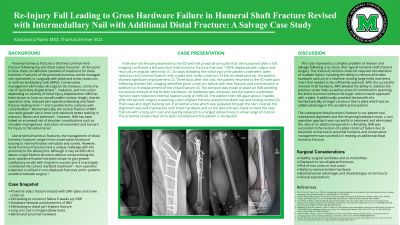Trauma
Category: Quickshot Oral Session 05
Quickshot Oral : Quickshot Oral Session 05
RE-INJURY FALL LEADING TO GROSS HARDWARE FAILURE IN HUMERAL SHAFT FRACTURE REVISED WITH INTERMEDULLARY NAIL WITH SUBSEQUENT DISTAL FRACTURE: A SALVAGE CASE STUDY
Saturday, February 11, 2023
3:00pm - 4:00pm East Coast USA Time


KASSANDRA FLORES, MS (she/her/hers)
MEDICAL STUDENT
Marshall University, United States- TE
THOMAS EMMER, MD
OTHOPAEDIC SURGERY, United States
Presenter(s)
Principal Contact(s)
Objectives: Proximal humerus fracture is the third common limb fracture. At this point in time, there no definitive standard of treatment for these fractures. These fractures can be managed non-operatively or surgically with plate and screw constructs or with intramedullary nails (IMNs). Conservative management eliminates surgical risk, however, carries risk of secondary displacement, malunion, and non-union. Compared to screw and plate construct, IMN has an overall smaller incision length, shorter operation time, reduced peri-operative bleeding and faster fracture healing time but carries risk of shoulder impingement and restriction of movement. Plating allows direct visualization and reduction of fractures as well as provides biomechanical advantages in bending resistance and torsion resistance.
Similar to proximal humerus fractures, the management of distal humerus fractures ranges from conservative functional bracing to internal fixation with plate and screws. However, distal humerus fractures have a unique challenge with the proximity to the elbow joint. Although it may be difficult to obtain a rigid fixation structure without compromising the joint, operative fixation has been shown to give greater satisfactory results with long term success and is now largely considered standard treatment. Non-operative treatment is utilized in non-displaced fractures and in patients unable to tolerate surgery.
Each approach has its own risks and benefits that should be considered for each patient and fracture. However, our patients with a repeat fractures and hardware failure posed particular surgical complexities. The choice of revision construct required consideration of multiple factors including the ability to remove all broken hardware, removal of screw shafts requiring use of a trephine creating large holes and stress risers that needed to be sufficiently spanned by the revision construct. With the successful removal of all hardware, IMN allowed the ability to stabilize the previous screw holes as well as areas of comminution spanning the entire humerus without the larger more invasive approach that would have been required to accomplish the same goals with a plate. It additionally provided the benefit of a biomechanically stronger construct than a plate which was an added advantage in this accident-prone patient. The subsequent distal humerus fracture in our patient had maintained alignment and the remaining hardware remained intact, a non-operative approach was successful in treatment and eliminated the risks of another operation. IMN was successful in the revision of a plate construct failure due to traumatic re-fracture in proximal humerus and conservative management was successful in treating an additional distal humerus fracture.
Methods:
Results:
Conclusion:
Similar to proximal humerus fractures, the management of distal humerus fractures ranges from conservative functional bracing to internal fixation with plate and screws. However, distal humerus fractures have a unique challenge with the proximity to the elbow joint. Although it may be difficult to obtain a rigid fixation structure without compromising the joint, operative fixation has been shown to give greater satisfactory results with long term success and is now largely considered standard treatment. Non-operative treatment is utilized in non-displaced fractures and in patients unable to tolerate surgery.
Each approach has its own risks and benefits that should be considered for each patient and fracture. However, our patients with a repeat fractures and hardware failure posed particular surgical complexities. The choice of revision construct required consideration of multiple factors including the ability to remove all broken hardware, removal of screw shafts requiring use of a trephine creating large holes and stress risers that needed to be sufficiently spanned by the revision construct. With the successful removal of all hardware, IMN allowed the ability to stabilize the previous screw holes as well as areas of comminution spanning the entire humerus without the larger more invasive approach that would have been required to accomplish the same goals with a plate. It additionally provided the benefit of a biomechanically stronger construct than a plate which was an added advantage in this accident-prone patient. The subsequent distal humerus fracture in our patient had maintained alignment and the remaining hardware remained intact, a non-operative approach was successful in treatment and eliminated the risks of another operation. IMN was successful in the revision of a plate construct failure due to traumatic re-fracture in proximal humerus and conservative management was successful in treating an additional distal humerus fracture.
Methods:
Results:
Conclusion:

